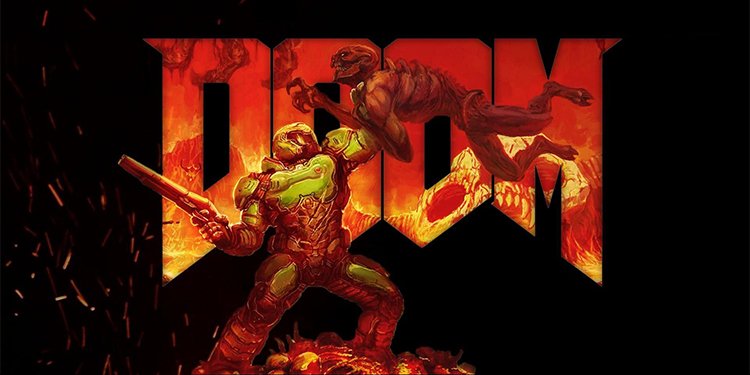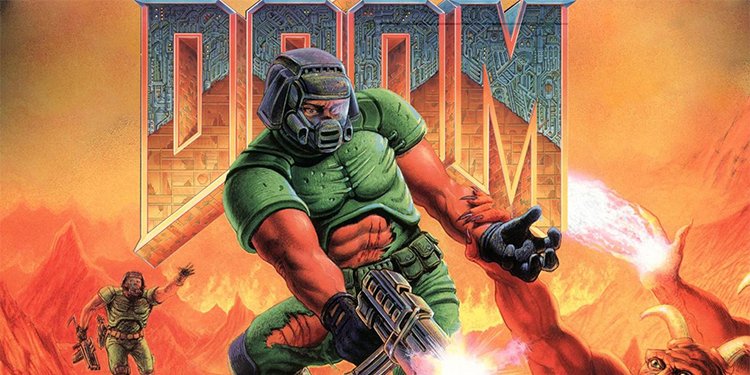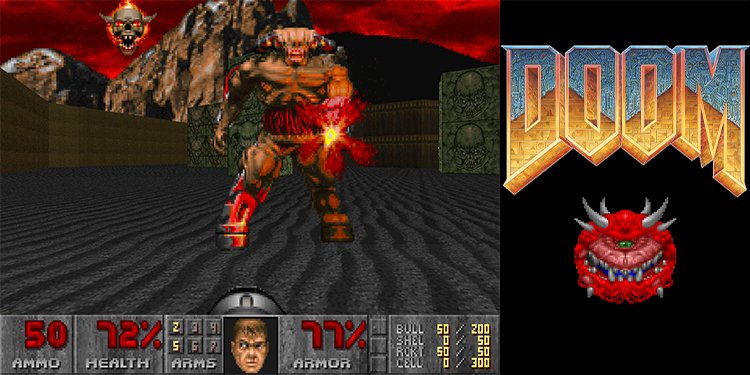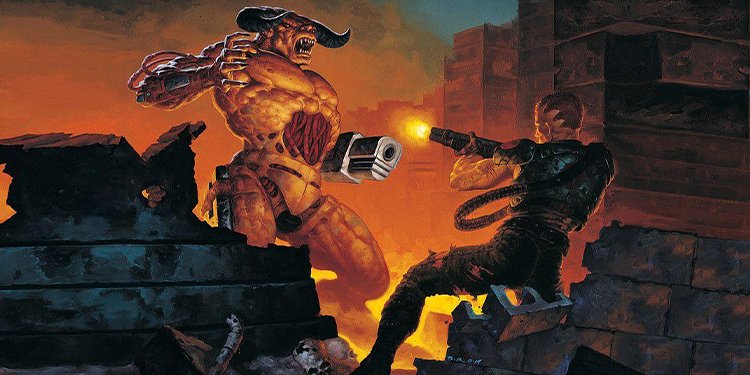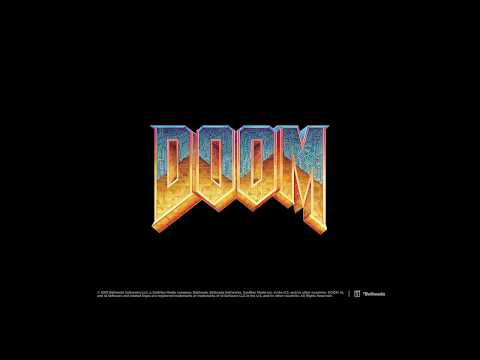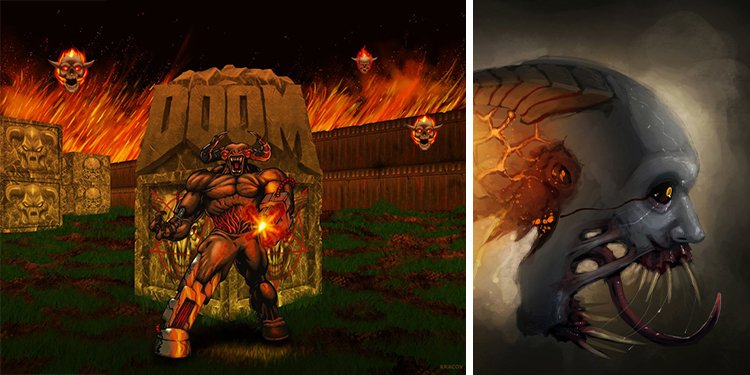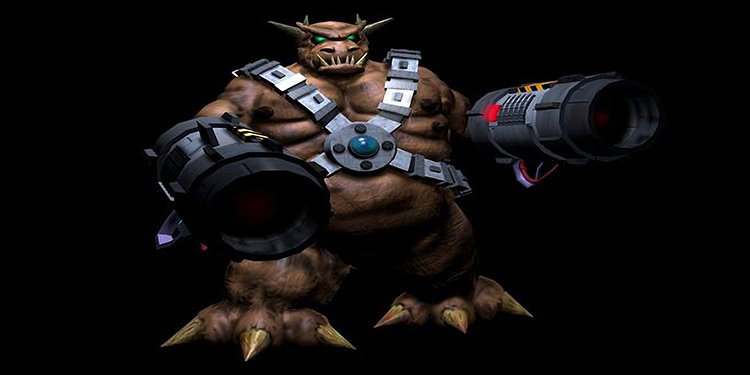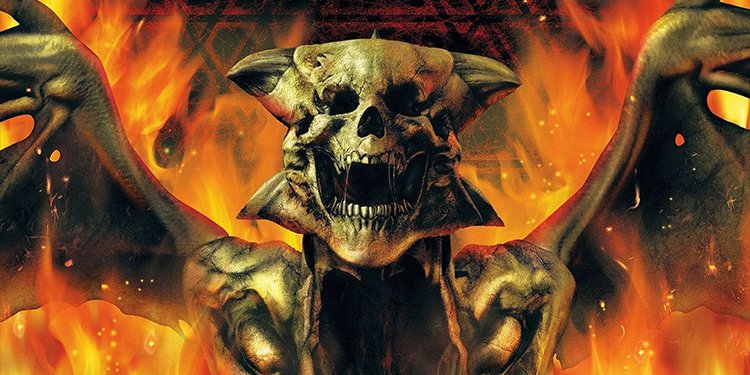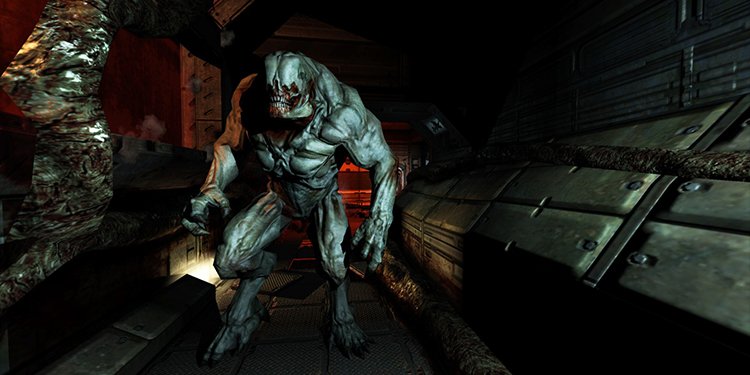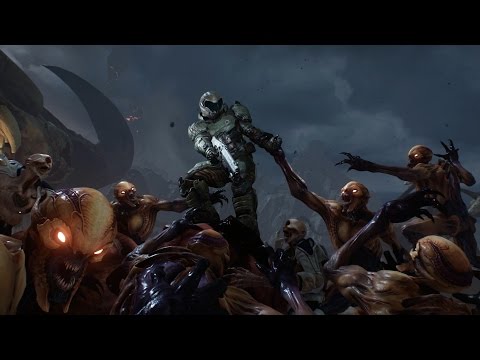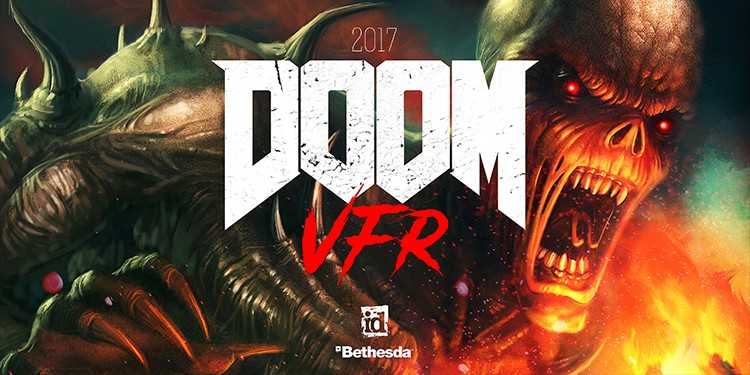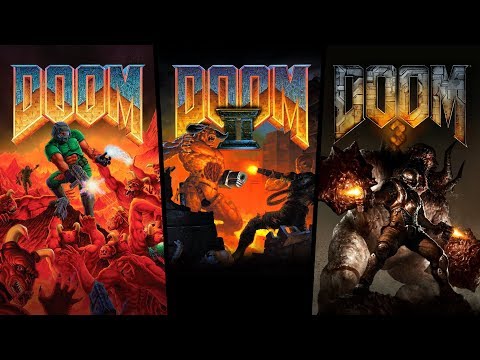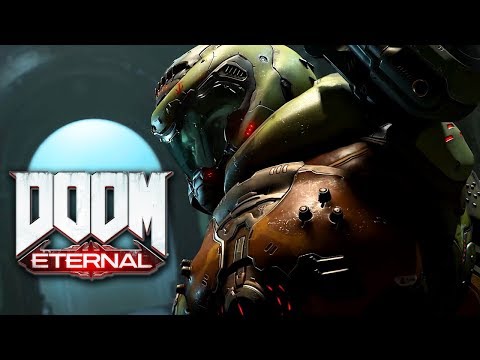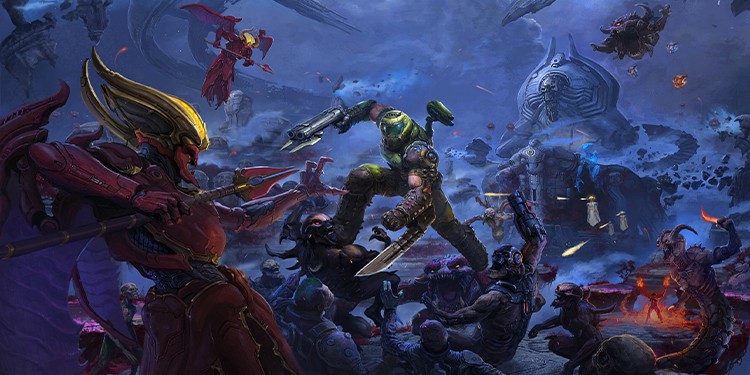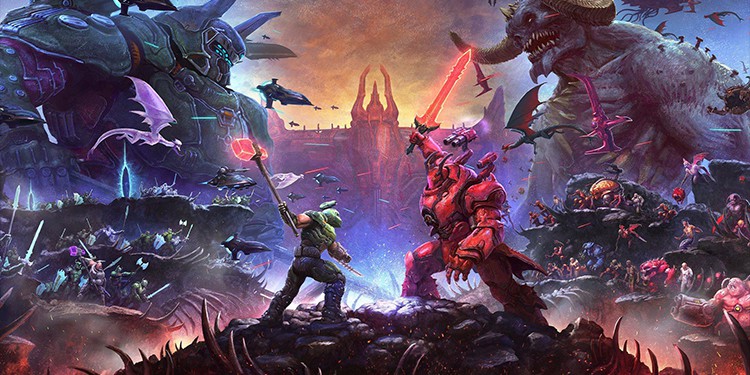The Video-game series Doom started in 1993. The original title defined the FPS genre and inspired numerous studios, clones, and sub-genres. Ever since, the saga has kept moving forward, pushing the genre’s envelope to deliver the best possible demon-slayer product. So far, we’ve seen five main Doom games, which are the ones iD Software created. Also, there’re various bundles, third-party entries, expansions, and a VR title. The total is 16 Doom entries.
All Doom Games in Order of Release Date
Id Software owns the Doom IP, and the studio has been at the helm of every title. Their formula is simple but effective. These are first-person shooters where you play as an ultimate badass. The “Doom Guy” is a space marine who “Fights Like Hell” for humanity. Overall, players combat against the forces of Hell (demons and the undead). There’s usually a big arsenal of weapons, each one featuring vastly different functionalities and advantages. The Slayer also has a sci-fi armor, the Praetor Suit. In some games, it can be upgraded to offer extra defensive, offensive, and mobility perks. Mobility is crucial on most Doom games: these titles are fast, chaotic, and furious. Players need to move fast and constantly swap their weapons to defeat the hellspawn. Game design is linear, meaning you have to complete various levels. These levels function as mazes, with main areas, side areas, collectibles, and hidden secrets. Overall, the Doom series comes in three parts. There’s the Classic Series (1993 – 1997), the Doom 3 era (2004 – 2012), and the rebooted series (2016 – ). Every main series game is available for modern consoles.
Classic Era
Doom – 1993 (Main series)
The original Doom debuted in 1993 for MS-DOS systems. Different editions and ports are available for Xbox One, PS4, Nintendo Switch, Android, and iOS. It was an FPS with early 3D graphics and 2D character models. An unnamed space marine ran through multiple military bases in Hell and bases on Mars’ moons. Each dungeon had various episodes, and the final area had a boss fight. Moreover, playing through the levels required managing health, armor, and ammo. Enemies were tough, plentiful, and vicious. The arsenal included a pistol, a plasma rifle, a pistol, power-ups, and the mighty BFG 9000. The plot was not as significant as the gameplay, but it was still there. The game had three episodes, and the lore came via short text segments between these episodes. After the “Doom Guy” assaulted a superior officer, he’s sent on a “suicide” mission to protect a combat force on various military bases.
Doom II: Hell on Earth – 1994 (Main Series)
Hell on Earth debuted for MS-DOS systems in 1994 and Macintosh PCs in 1995. Currently, you may find it on Xbox 360, Xbox One, PS4, Nintendo Switch, iOS, Android, and Windows. Moreover, developers took advantage of new computer hardware to improve the engine and create more complex levels. Dungeons became wider and nonlinear, and each level had more demons to defeat. The gameplay had 32 levels, although two of these were secret levels. Players found twice as much enemy variety, multiple boss fights, and a wider arsenal. Particularly, Doom II introduced the iconic double-barreled shotgun. As for the plot, Doom II follows the events of the first game. After the Slayer defeats the Spider Mastermind, new demons open a portal to Earth. Surviving humans escaped in massive spaceships, but demons overran the Earth’s last spaceports. The Space Marine is the only one capable of saving humanity from the hordes of Hell.
Master Levels for Doom II – 1995
In 1995, iD Software released the first Doom II expansion. Master Levels brought 20 extra levels with increased challenge and enemy numbers compared to the base game.
Thy Flesh Consumed (The Ultimate Doom) – 1995 (Doom II Expansion)
The fourth episode of the original game premiered as a post-launch expansion. It’s available on the Ultimate Doom version and not in the original version. That said, Ultimate Doom is available on Steam for Windows consoles. Thy Flesh Consumed premiered in 1995. It’s a Doom II prequel where the Slayer fights against a demon invasion to Earth. Id Software was developing the Quake series by the time, so third-party studios created the expansion. Gameplay-wise, the expansion is more challenging than the base game. Lastly, Ultimate Doom is not open-code shareware anymore. It’s the retail re-release of the original game.
Final Doom – 1996 (Third-party Entry)
Modding group TeamTNT released Final Doom in 1996 under supervision by iD Software. The original developers were working on the Quake saga by the time. Final Doom debuted for MS-DOS, Macintosh PCs, and PlayStation. It’s currently available on Nintendo Switch, PlaySation 4, and Xbox One. The third-party title compiles two stand-alone episodes for Doom II. Each episode is a campaign on its own (Evilution and the Plutonmia Experiment). The first part is about avenging fallen comrades; the second part is about closing the gates of Hell. There’re 32 levels in the game, and the story takes place after Doom II. Gameplay-wise, it’s almost the same as Doom II, although it’s more difficult than previous entries. For example, there’s no life regeneration in Final Doom.
Doom 64 – 1997 (Third-party Entry)
Doom 64 debuted for Nintendo 64 in 1997. Bethesda released a remastered port in 2020, and it’s available for Windows, Nintendo Switch, PS4, Google Stadia, and Xbox One. Doom 64 plays similar to earlier games. Players advance through 28 levels, 4 secret levels, and hordes of demons. The difference is the game had a new engine to greatly improve visuals, character models, weapon models, and performance. The story follows the Doom Guy after defeating the Hell invasion on Hearth. A new mission sends the space marine to a Union Aerospace Corporation base to hunt for a dangerous entity. The new enemy appears to have high radiation levels, corrupted tissue, and abilities to resurrect the dead. However, this was all a plot to trap the Doom Guy in Hell. They thought they trapped the marine in the eternal fires, but in reality, they were trapped in the underworld with the Slayer. And so, the game ends with the Doom Guy deciding to stay in Hell forever, ensuring no demon rises again.
Doom 3 Era
Doom 3 – 2004 (Main Series)
Doom 3 (DOOM) debuted in 2004 for Windows. Later on, it became available for Linux, macOS X, and Xbox. It’s the first reboot of the series, featuring a new story but similar lore and gameplay elements. The story takes the Doom Guy to Mars in the year 2145. A military conglomerate is researching teleportation, advanced weapons, and bio-weaponry. These experiments open a gateway to Hell, which results in a demon invasion of Mars. Needless to say, the Slayer defeats the demon hordes. Doom 3 features a story-driven campaign with the main goal of defeating several enemies and reaching the exit points to complete levels. The game also features NPCs with key information, inventory items, and objectives. The shooting is better than ever. There’re ten weapons available, which include the BFG 9000 and experimental plasma weapons. The enemy variety is wide, and they feature different abilities, weaknesses, and behaviors. Also, the game uses horror elements to aim the series into a horror/survival setting. For example, players must choose between holding a flashlight or holding a weapon. Lastly, Doom 3 has various 4-player multiplayer deathmatch modes. The community later modded the feature to allow up to 16 players.
Doom 3: Resurrection of Evil – 2005 (Doom 3 Expansion)
Resurrection of Evil is a Doom 3 expansion by Nerve Software. It debuted for Windows in 2005 and Xbox. Currently, it’s available for Windows as well. The sequel features 12 single-player levels, six new enemies, and several new multiplayer maps. Also, it brings back the double-barreled shotgun from Doom II. It also adds two features. The first one is the Ionized Plasma Levitator, a weapon that picks and moves certain items, as well as small projectiles. Interestingly, it’s quite similar to Half-Life 2’s Gravity Gun, and Valve’s game debuted in the same year. The second feature is the Heart of Hell and the Bloodstone, demonic Artifacts with three abilities. These become available to the Slayer after defeating three bosses.
Doom II: No Rest for the Living – 2010 (Doom II Expansion)
No Rest for the Living is the second expansion for Doom II. It premiered for Xbox 360 in 2010. Nerve Software creates the pack under iD Software supervision. The expansion has 8 new levels and one secret level. It takes place after Doom II’s campaign, and it works as a homage to the original Doom.
Doom 3: BFG Edition – 2012 (Remaster & Bundle)
The BFG Edition is a Doom 3 remaster. It debuted in 2012 for Windows, Xbox 360, and PS3. It’s also currently available for Windows. BFG brings enhanced graphics, improved audio, extra horror sound effects, and checkpoints. Other additions include 3D display support and HDM support. Gameplay-wise, it also added the ability to use the flashlight and weapons at the same time. The BFG Edition is also a bundle that includes:
Doom Classic Complete – 2012 (Bundle)
Doom Classic Complete is a Doom bundle that originally debuted for PS3 in 2012. It’s currently available at Steam. It includes:
Rebooted Series
Doom – 2016 (Main Series)
Doom is the 2016 reboot of the series. iD Software is the sole developer, and Bethesda Softworks became the publisher this time around. A new Doom Slayer comes back to fight against the forces of Hell. Demons and undead are attacking a UAC on their Mars facility. The Slayer must drive the hellspawn back to where they belong. Doom 2016 features a character progression system, environmental traversal, enhanced mobility skills, and a wide arsenal. On top of that, it features multiple enemies, each one having weak spots, behaviors, and skills. Also, the game introduced the “Glory Kills” system. After staggering an enemy with enough damage, the Slayer can kill it with a special melee action. A glory kill refills ammo. Similarly, you can kill most weak enemies with a chainsaw or kill an injured strong enemy with the weapon. It restores ammo instead of health. With these two features plus enhanced mobility, Doom became a frenetic micro-management of HP, Ammo, and chainsaw fuel. Aside from that, the graphics, soundtrack, and campaign were stellar, the best the series has ever been.
Doom VFR – 2017 (VR Spin-off)
Doom VFR by iD Software it’s the first Doom VR title. It debuted in 2017 for Windows (Oculus Rift and HTC Vive) and PlayStation VR. You don’t get to play as the Slayer, though. Instead, you play as a cybernetic survivor, a UAC soldier that fights a demon invasion of Mars. It’s a canon story that happens after Doom II. The gameplay allows you to travel across the UAC facility, teleport, use a jet-strife, and use multiple weapons to fight. You’d have to customize the key binding to make it work for you, as the game is tough, and VR games can be clumsy. After you tweak the controllers, it can be a great game, brutal and smooth. However, turning and moving in VR is challenging, and the Doom series requires fast mobility. If you already have a VR setup, and if you’re a Doom 2016, you should give it a try.
Doom Re-release – 2019
In 2019, Bethesda re-released Doom, Doom II, and Doom 3 for iOS, Android Xbox One, PS4, Windows, and Nintendo Switch.
Doom Eternal – 2020 (Main series)
Doom Eternal debuted for PS4, Xbox One, Windows, and Google Stadia in 2020. There’s also an optimized version for new-gen consoles. Doom Eternal perfected the Doom 2016 formula and added extra elements. For starters, most weapons have two variations and levels up in two different pathways. You’d need to use every weapon as each enemy features specific weaknesses. Secondly, the Praetor Suit has several upgrades, perks that enhance grenades, the fire thrower, mobility, and more. Thirdly, you can have three additional perks active at any time (runes). These are runes you find through exploration, and they greatly improve and change your gameplay style. Aside from that, the game is a system that shows how the Doom Guy damages enemies. As you chip at the monster, you’ll see how their flesh, bones, and armor fall down. The game is linear, but the maps are wide and full of secrets. One of these secrets is unlocking the full original Doom game. Speaking of which, the hub (The Fortress of Doom) has some secrets as well. It’s a place where you can unlock some weapons, skins, and upgrades. Also, you can chill and hear the Doom soundtrack (which are collectibles) and choose to replay previous missions with or without cheat codes (collectibles as well). Better yet: you can go to the Slayer’s room and play the original Doom. These elements, on top of multiple platforming sections, created the most frenetic shooter you can play. It’s fast, explosive, challenging, and tough to master. It’s also highly addictive. The story picks up the Doom Guy on a mission to end Hell’s invasion of Earth. The Slayer foils the plans of the Maykr alien to exterminate humanity. At the same time, you uncover multiple lore elements. These include the Slayer’s background story, the divine Mayrk alien race, and more. The game also includes a multiplayer mode, “Battlemode.” It delivers matches between a Doom Slayer and a demon.
Doom Eternal: The Ancient Gods Part I – 2020 (Doom Eternal Expansion)
Doom Eternal ends when the Slayer defeats the Icon of Sin, therefore halting Hell’s invasion on Earth. The victory had a consequence, though. The Hell forces conquered Urdak, the heavens where the Maykr race resides. They needed Hell to succeed on Earth, as they used the energy created by suffering souls to power their technology. The Slayer, alongside scientist Samuel Hayden and other allies, set out to save the divine race. Gameplay-wise, the expansion plays across three levels and adds several new enemies.
Doom Eternal: The Ancient Gods Part II – 2021 (Doom Eternal Expansion)
The Ancient Gods Part II debuted in 2021. It takes the Doom Slayer to Immora, the Hell capital, to defeat the Dark Lord in a final confrontation. The setting opens up the craziest, most creative scenarios the series has ever seen. The Doom Slayer visits various planets and dimensions, meets several deities, and uncovers significant lore information. The expansion features various new enemies, an excruciating final battle, a new weapon, and four levels.
Every Doom Game in Chronological Order
Are There Mobile Doom Games?
There’re various spin-off mobile games, but these aren’t available anymore. These are:
